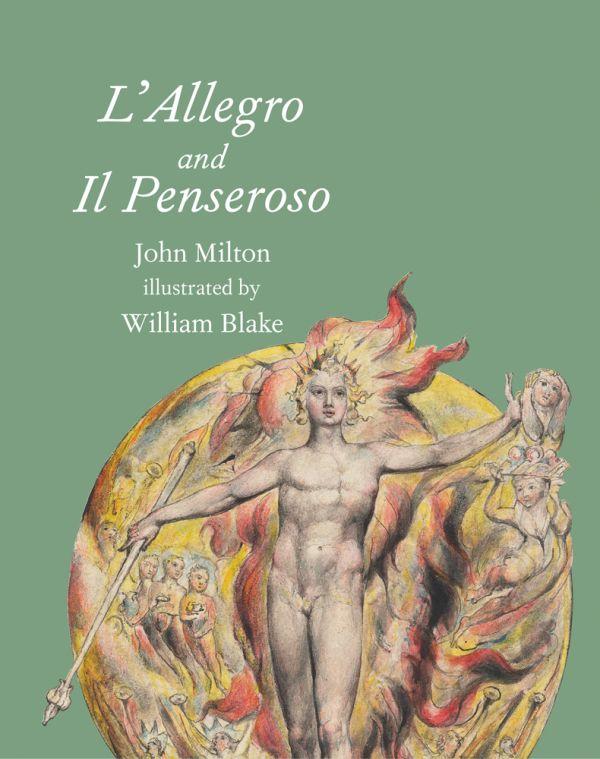
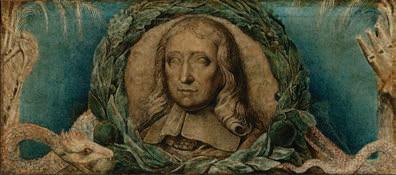



John Milton (1608-1674) wrote L’Allegro (‘The Happy Man’) and Il Penseroso (‘The Melancholy Man’) shortly after he left Cambridge, where he took his MA in 1632. They were first published in Poems of Mr. John Milton both English and Latin, compos’d at several times, dated 1645.
The poems remained popular throughout the eighteenth century. Dr Johnson wrote, in his biography of Milton:
Of the two pieces, L’Allegro and Il Penseroso, I believe opinion is uniform; every man that reads them, reads them with pleasure. The author’s design is not, what Theobald has remarked, merely to shew how objects derived their colours from the mind, by representing the operation of the same things upon the gay and the melancholy temper, or upon the same man as he is differently disposed; but rather how, among the successive variety of appearances, every disposition of mind takes hold on those by which it may be gratified.
Milton’s poetry deeply marked Blake from his earliest years. In 1800, he wrote to his friend and fellow artist, John Flaxman, ‘Milton lovd me in childhood & shewd me his face’. In 1801 Blake began to produce watercolour illustrations for Milton’s poetry for the Rev. Joseph Thomas, and his engagement with his great predecessor culminated in his illuminated book Milton a Poem. Written c. 1804-11, this imagines Milton returning from Heaven, to join his successor, Blake. Starting in 1808 Blake was commissioned by the civil servant Thomas Butts to make versions of the Milton illustrations created earlier for the Rev. Joseph Thomas, and around 1816-20 Blake added to Butts’ collection the twelve completely new designs for L’Allegro and Il Penseroso reproduced here. Unusually, Blake also wrote comments to explain his compositions, and these we have printed as captions.
After being sold by Butts’ family, the watercolours belonged to the collector, critic and patron of literature, Richard Monckton Milnes, 1st Baron Houghton. In 1949 they were bought by the Pierpont Morgan Library, New York, to whom many thanks.
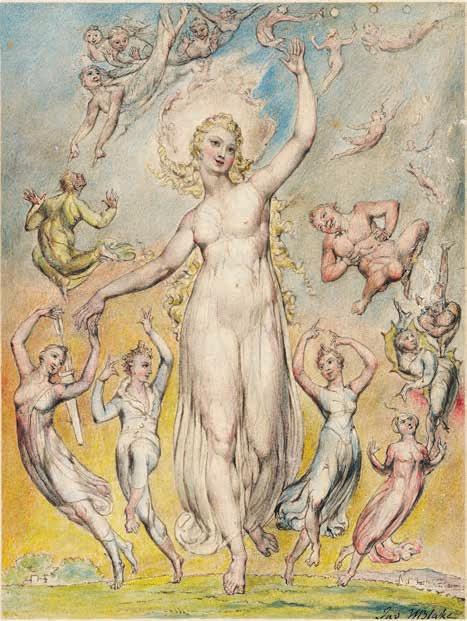
Hence loathed Melancholy, Of Cerberus, and blackest Midnight born, In Stygian cave forlorn, ’Mongst horrid shapes, and shrieks, and sights unholy; Find out some uncouth cell, Where brooding Darkness spreads his jealous wings, And the night-raven sings; There under ebon shades, and low-brow’d rocks, As ragged as thy locks, In dark Cimmerian desert ever dwell. 10
But come thou goddess fair and free, In heav’n yclep’d Euphrosyne, And by men, heart-easing Mirth, Whom lovely Venus at a birth With two sister Graces more To Ivy-crowned Bacchus bore; Or whether (as some sager sing) The frolic wind that breathes the spring, Zephyr, with Aurora playing, As he met her once a-Maying, 20 There on beds of violets blue, And fresh-blown roses wash’d in dew, Fill’d her with thee, a daughter fair, So buxom, blithe, and debonair. Haste thee nymph, and bring with thee
Illustration to lines 13 and 25-8, 31-6. ‘These Personifications’ — that is, ‘Jest, & Youthful Jollity, Quips & Cranks & Wanton Wiles, Nods & Becks & wreathed smiles Sport that wrinkled Care derides, And Laughter holding both his sides,’ and, holding Mirth’s right hand, the Mountain Nymph Sweet Liberty — ‘are all brought together in the First Design. Surrounding the Principal Figure which is Mirth herself.’
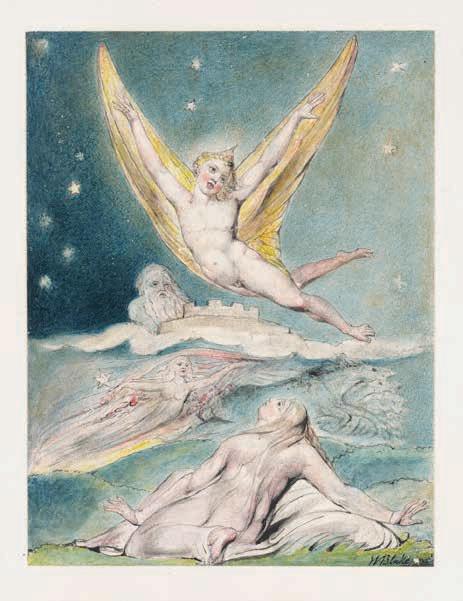

Jest and youthful Jollity, Quips and cranks, and wanton wiles, Nods, and becks, and wreathed smiles, Such as hang on Hebe’s cheek, And love to live in dimple sleek; 30 Sport that wrinkled Care derides, And Laughter holding both his sides. Come, and trip it as ye go On the light fantastic toe, And in thy right hand lead with thee, The mountain-nymph, sweet Liberty; And if I give thee honour due, Mirth, admit me of thy crew
To live with her, and live with thee, In unreproved pleasures free; 40
To hear the lark begin his flight, And singing startle the dull night, From his watch-tower in the skies, Till the dappled dawn doth rise; Then to come in spite of sorrow, And at my window bid good-morrow, Through the sweet-briar, or the vine, Or the twisted eglantine; While the cock with lively din, Scatters the rear of darkness thin, 50 And to the stack, or the barn door, Stoutly struts his dames before; Oft list’ning how the hounds and horn Cheerly rouse the slumb’ring morn,
Illustration to lines 41-4. ‘The Lark is an Angel on the Wing. Dull Night starts from his Watch Tower on a Cloud. The Dawn with her dappled Horses arises above the Earth. The Earth beneath awakes at the Larks Voice.’
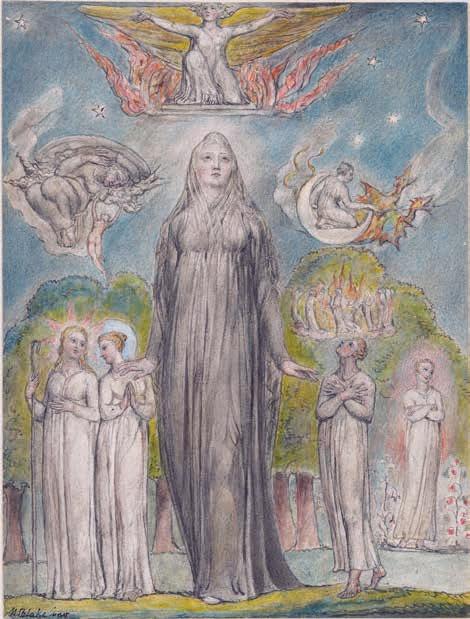
Hence vain deluding Joys, The brood of Folly without father bred, How little you bested, Or fill the fixed mind with all your toys; Dwell in some idle brain, And fancies fond with gaudy shapes possess, As thick and numberless
As the gay motes that people the sunbeams, Or likest hovering dreams, The fickle pensioners of Morpheus’ train. 10
But hail thou goddess, sage and holy, Hail divinest Melancholy, Whose saintly visage is too bright To hit the sense of human sight; And therefore to our weaker view, O’er-laid with black, staid Wisdom’s hue; Black, but such as in esteem, Prince Memnon’s sister might beseem, Or that starr’d Ethiop queen that strove To set her beauty’s praise above 20 The sea nymphs, and their powers offended. Yet thou art higher far descended, Thee bright-hair’d Vesta long of yore, To solitary Saturn bore; His daughter she (in Saturn’s reign, Such mixture was not held a stain)
Illustrations of lines 31-3, 37-3, 45-54, 56-60. ‘These Personifications’ — that is, Peace & Quiet, Spare Fast... the Muses in a Ring, retired Leisure... the Cherub Contemplation ... and Cynthia, the Moon, driving her dragons —are all brought together in this design surrounding the Principal Figure Who is Melancholy herself.’
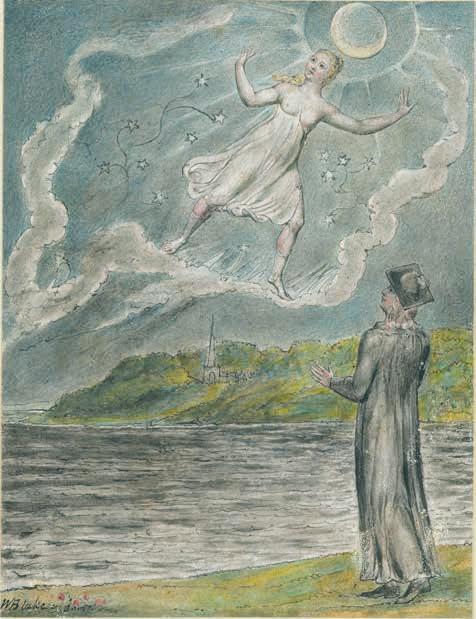
Oft in glimmering bow’rs and glades He met her, and in secret shades Of woody Ida’s inmost grove, While yet there was no fear of Jove. 30 Come pensive nun, devout and pure, Sober, stedfast, and demure, All in a robe of darkest grain, Flowing with majestic train, And sable stole of cypress lawn, Over thy decent shoulders drawn. Come, but keep thy wonted state, With ev’n step, and musing gait, And looks commercing with the skies, Thy rapt soul sitting in thine eyes: 40 There held in holy passion still, Forget thyself to marble, till With a sad leaden downward cast, Thou fix them on the earth as fast. And join with thee calm Peace, and Quiet, Spare Fast, that oft with gods doth diet, And hears the Muses in a ring, Aye round about Jove’s altar sing. And add to these retired Leisure, That in trim gardens takes his pleasure; 50 But first, and chiefest, with thee bring Him that yon soars on golden wing, Guiding the fiery-wheeled throne, The cherub Contemplation; And the mute Silence hist along, ’Less Philomel will deign a song,
Illustration to lines 67-76. ‘Milton in his Character of a Student at Cambridge. Sees the Moon terrified as one led astray in the midst of her path thro heaven. The distant Steeple Seen across a wide water indicates the Sound of the Curfew Bell.’